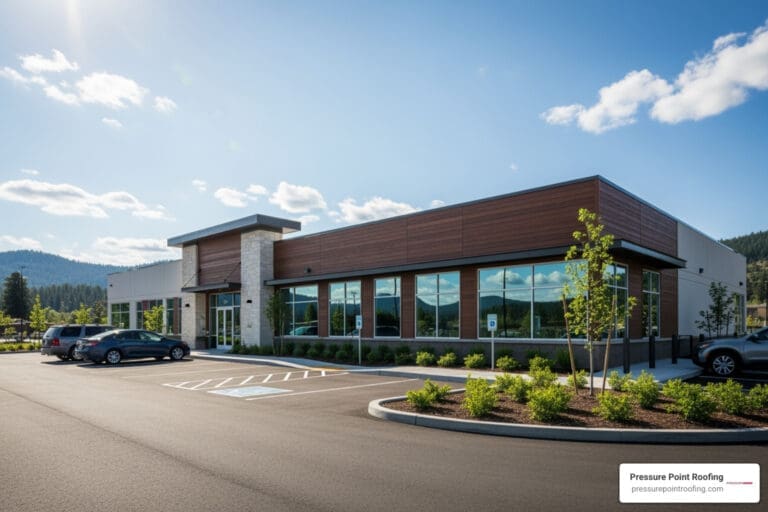Signs Your Roof Ventilation System Needs Work
 A properly functioning roof ventilation system helps regulate airflow, prevents moisture buildup, reduces energy costs, and extends the life of your roof. When it isn’t working properly, your home can suffer numerous issues that can quickly turn into expensive repairs. In other words, a properly functioning roof ventilation system is crucial for maintaining the health and longevity of your home. Wondering if your roof’s ventilation system needs work? Here are some telltale signs that our team of experts at Pressure Point Roofing would look out for.
A properly functioning roof ventilation system helps regulate airflow, prevents moisture buildup, reduces energy costs, and extends the life of your roof. When it isn’t working properly, your home can suffer numerous issues that can quickly turn into expensive repairs. In other words, a properly functioning roof ventilation system is crucial for maintaining the health and longevity of your home. Wondering if your roof’s ventilation system needs work? Here are some telltale signs that our team of experts at Pressure Point Roofing would look out for.
Top Signs Your Home’s Roof Ventilation System Needs Work
1. Hot Attic in the Summer
One of the most evident signs of poor roof ventilation is excessive heat buildup in the attic during the summer months. While it’s normal for an attic to be warmer than the rest of your house, it shouldn’t feel like a sauna. If you notice that your attic is unbearably hot, your ventilation system may not be effectively circulating air, causing heat to be trapped, which can lead to premature shingle aging and increased energy bills.
2. High Energy Bills
Poor roof ventilation could be the culprit if your energy bills are climbing higher than usual. When hot air gets trapped in the attic, your HVAC system has to work harder to keep the rest of your home cool, leading to increased energy consumption. Similarly, when cold air gets trapped during the winter, it can cause your heating system to overwork. If you’ve noticed a spike in energy costs, it might be time to check your roof’s ventilation.
3. Moisture and Mold in the Attic
A properly functioning roof ventilation system prevents excess moisture from building up in your attic. If you notice condensation, water stains, or worse, mold growth, it’s a clear indication that your roof ventilation is not working properly. Left unchecked, moisture can cause significant damage to insulation, wood structures, and even the roofing materials themselves. Mold can also lead to serious health issues, so it’s vital to immediately address this problem.
4. Ice Dams in the Winter
Ice dams form when warm air escapes from your attic and melts the snow on the roof. The melted snow then refreezes at the roof’s edges, creating ice dams that can cause significant water damage by seeping under your shingles, leading to leaks inside your home. If you’ve had issues with ice dams in the past, your roof ventilation likely needs improvement.
5. Visible Rust or Corrosion
If you find rust on metal components like nails, vents, flashing, or other roof structures in your attic, it could indicate excessive moisture caused by poor ventilation. Over time, this rust can weaken the integrity of your roof, making it more vulnerable to leaks and structural damage. Addressing ventilation issues early can prevent costly repairs down the line.
6. Unpleasant Odors
A musty or moldy smell in your attic or upper levels of your home is another red flag that your roof’s ventilation system isn’t doing its job. When air isn’t circulating properly, moisture can get trapped, creating the perfect environment for mold and mildew, which often produces unpleasant odors. If you notice strange smells in your living spaces, inspecting your attic and assessing the ventilation system is a good idea.
7. Peeling Paint and Warped Wood
The excessive heat and moisture buildup from inadequate roof ventilation can lead to peeling paint or warped wood on your ceiling or walls. This is especially noticeable on the upper levels of your home. If you spot peeling paint, wood warping, or even peeling wallpaper near the roofline, it could be due to poor airflow in the attic, which needs to be addressed to prevent further damage.
8. Uneven Shingle Wear
Roof shingles are designed to withstand the elements, but shingles exposed to excessive heat and moisture from inside the attic may degrade faster, causing uneven wear and shortening the life of your roof. If you notice curling, cracking, or blistering shingles, it may be a sign that your attic is too hot and your ventilation system isn’t providing enough airflow.
9. Frequent Roof Repairs
If you constantly need to repair your roof, poor ventilation may be the underlying issue. A roof that isn’t adequately ventilated will suffer from excess heat, moisture, and pressure, which can cause premature aging of the roofing materials. If you’ve had to repair your roof frequently, it may be time to evaluate and improve your roof’s ventilation system.
Address Your Roof’s Ventilation Problems with Pressure Point Roofing
If you’ve noticed any of these signs in your home, contact the professionals at Pressure Point Roofing before the issues get worse. Our team of experts can inspect your roof’s ventilation system and assess whether your current ventilation is adequate for your home, recommending any necessary improvements.
Investing in proper roof ventilation not only extends the life of your roof but also saves you money in the long run by preventing expensive repairs, lowering your energy bills, and maintaining a healthy home environment.
Don’t wait until it’s too late. By staying alert to the signs that your roof’s ventilation system needs work, you can address problems early and avoid costly repairs down the road. Contact Pressure Point Roofing today to schedule an inspection.
Schedule a Consultation
By submitting this form, I agree to receive calls and text messages (including those sent using automated technology) from Pressure Point Roofing, LLC and its representatives at the number provided. Message and data rates may apply. Message frequency may vary. Consent is not required as a condition of purchase. Reply STOP to unsubscribe at any time.
Related Content
Partners and Awards












